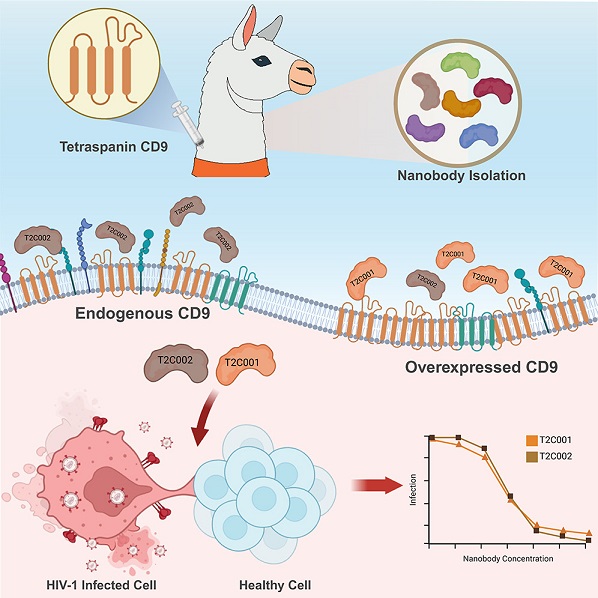New nanobodies show promise in inhibiting HIV-1 replication by targeting CD9 protein
Nikhil Prasad Fact checked by:Thailand Medical News Team Sep 16, 2024 1 year, 3 months, 1 week, 5 days, 2 hours, 41 minutes ago
HIV News: Researchers from the Amsterdam University Medical Center (UMC) and the Amsterdam Institute for Immunology and Infectious Diseases in Netherlands have developed a promising new approach to inhibit HIV-1 replication by targeting the CD9 protein, a key player in cell membrane organization. The study, which was conducted in collaboration with QVQ Holding BV, marks a significant shift towards host-targeted therapies that could work in tandem with existing antiretroviral treatments. This
HIV News report discusses how the team created llama-derived nanobodies against CD9 and their potential to disrupt HIV-1 replication.
 Graphical Abstract. New nanobodies show promise in inhibiting HIV-1 replication by targeting CD9 protein
Graphical Abstract. New nanobodies show promise in inhibiting HIV-1 replication by targeting CD9 protein
CD9, a member of the tetraspanin protein family, plays a crucial role in cell fusion processes and viral entry and exit mechanisms. By targeting CD9, the researchers hope to disrupt these processes and prevent HIV-1 from replicating and spreading.
Understanding the Role of CD9 in HIV-1 Replication
HIV-1 has long been a global health challenge, and although antiretroviral therapy (ART) has been effective in controlling viral replication, it is not without its limitations. ART primarily targets viral components and cannot eliminate latent viral reservoirs, which remain dormant in the body. Host-targeting strategies offer a new way to combat HIV by focusing on essential host factors involved in the virus's life cycle. CD9, a protein involved in various cellular processes such as signaling, adhesion, and fusion, has emerged as a target for viral inhibition.
In HIV-1 infection, CD9 is upregulated, facilitating the virus's ability to exit infected cells and spread to new ones. Previous research has shown that downregulating CD9 can reduce HIV-1 replication, leading researchers to investigate how targeting this protein might help disrupt the virus's life cycle.
Development of Nanobodies Against CD9
The researchers in this study generated llama-derived nanobodies specifically targeting the large extracellular loop (LEL) of the CD9 protein. After immunizing llamas with recombinant CD9 LEL, they identified eight distinct nanobodies, each with different affinities and binding properties. Among these, two nanobodies - T2C001 and T2C002 - showed the highest affinity for CD9, making them prime candidates for further investigation.
Although these nanobodies did not inhibit the early stages of HIV-1 infection, they were effective at blocking cell-cell spread and reducing HIV-1 replication in T cells and macrophages, key cell types involved in the virus's transmission.
How CD9 Nanobodies Inhibit HIV-1 Replication
Nanobodies T2C001 and T2C002 were particularly effective at inhibiting syncytia formation, a process where infected cells fuse to form large, multinucleated cells that contribute to HIV-1's rapid spread. The nanobodies blocked the formation of these syncytia in a dose-dependent manner, with T2C002
showing stronger inhibition than T2C001.
The nanobodies were also tested for their ability to inhibit HIV-1 replication in T cells and macrophages. T2C002, in particular, showed a significant reduction in the levels of CA-p24, a viral protein used to measure HIV-1 replication. This inhibition was observed not only in T cells but also in macrophages, which are considered crucial reservoirs for the virus. By reducing the release of HIV-1 from infected macrophages, the nanobodies demonstrated their potential to limit the virus's spread in the body.
The Role of CD9 in Cell Membrane Organization and Viral Release
CD9 belongs to the tetraspanin family, a group of proteins that act as "organizers" of the cell membrane. These proteins help cluster other proteins and organize them into specialized areas called tetraspanin-enriched microdomains (TEMs), which are essential for many cellular processes. In the context of HIV-1 infection, tetraspanins like CD9 are involved in the virus's release from infected cells.
The research team found that CD9-directed nanobodies disrupted this process by preventing the virus from exiting infected cells. This finding suggests that targeting CD9 could be an effective strategy for limiting viral replication and spread.
Potential Synergy with Existing Treatments
One of the most exciting aspects of this study is the potential for CD9-targeting nanobodies to work in conjunction with existing HIV-1 treatments. The researchers observed that combining nanobodies with broadly neutralizing antibodies (bnAbs) or ART could enhance their effectiveness. By targeting both viral and host factors, this combination therapy could provide a more comprehensive approach to controlling HIV-1.
In particular, the combination of T2C002 with J3, a nanobody that targets HIV-1 Env proteins, showed an additive effect in inhibiting HIV-1 replication. This finding paves the way for the development of bispecific antibodies that can target both CD9 and HIV-1 Env proteins, offering a dual approach to halting the virus.
Conclusions and Future Directions
The study's findings suggest that nanobodies targeting CD9 represent a promising new strategy for inhibiting HIV-1 replication. By disrupting the virus's ability to exit infected cells and spread to new ones, these nanobodies could complement existing therapies and offer new hope for individuals living with HIV.
In addition to their potential use in HIV-1 treatment, CD9-directed nanobodies could have applications in other areas of medicine, including cancer therapy and diagnostics. The ability of these nanobodies to discriminate between different forms of CD9 (such as overexpressed or clustered CD9) could make them valuable tools for detecting and treating diseases where CD9 plays a role.
The researchers acknowledge that further studies are needed to fully understand the mechanisms by which these nanobodies inhibit HIV-1 replication. Future research may focus on structural studies to determine the exact binding sites of the nanobodies on CD9 and their interactions with other proteins on the cell surface. Additionally, the development of bispecific antibodies that target both viral and host proteins could lead to even more effective treatments.
The study findings were published in the peer-reviewed journal: iScience.
https://www.sciencedirect.com/science/article/pii/S2589004224021837
For the latest
HIV News, keep on logging to Thailand Medical News.
Read Also:
https://www.thailandmedical.news/news/hiv-increases-heart-disease-risk
https://www.thailandmedical.news/news/a-breakthrough-in-hiv-research-the-role-of-cd28-in-modulating-t-cell-functions-uncovered
